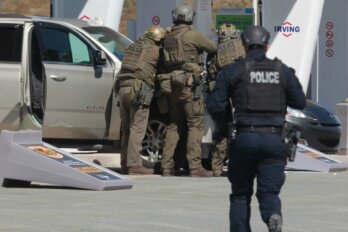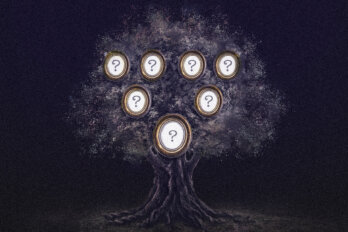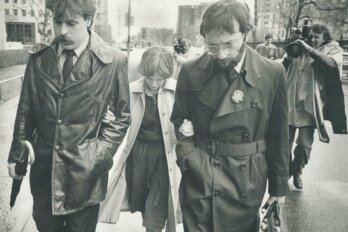Across Canadian cities there is an invisible perimeter. It’s one that demarcates when and where (and to whom) gun violence is allowed to happen. And even though gun violence has been increasing in Canada since 2013, many in the country have only recently called attention to the problem—or even realized it existed. There’s a reason for the cyclical interest, which only spikes when certain gun crimes capture general interest: once that invisible perimeter is breached, the public’s tolerance for gun violence collapses. It happened in Toronto on June 14 when two young girls were shot on a playground in the city’s east end. A series of other high-profile shootings followed: on Canada Day weekend, two men were killed and a third woman injured on a busy street, sending people running for their lives. Then, more recently, a teenager and ten-year-old girl were killed and thirteen others injured in a mass shooting along a popular restaurant strip on the Danforth in Greektown.
In Regina, there was a 17 percent increase in violent gun crimes over the first seven months of 2018 compared to the same time last year. Ottawa broke its gun-violence record in 2016 with fifty-one shootings by early October; this year, the city reached that number in early July. In Surrey, BC, children as young as ten are being recruited to join gangs. There, residents’ frustrations reached an all-time high in late June after three people—as CTV Vancouver highlighted—“without criminal records” were killed that month, prompting one local to call it a “tipping point.”
All these shootings either took place in areas generally considered safe (the Canada Day weekend violence and mass shooting were in central Toronto) or to people who weren’t supposed to be victims (children in Toronto, people without criminal records in Surrey). This public sentiment that certain people aren’t supposed to be shot comes from bias—a bias that presupposes others are supposed to be shot. And this bias is about more than just who we believe deserves to be shot. It has also infiltrated the very way we talk about victims and shooters.
After the June attack in Toronto’s east end, Toronto mayor John Tory called the shooters “profoundly antisocial sewer rats.” Writer and activist Desmond Cole noted that in using dehumanizing terms to describe people who commit these crimes—which, he points out, are overwhelmingly associated with Black people—as vermin, we are essentially saying they deserved to be killed.
Canada hasn’t executed someone convicted of a criminal offence since 1962. This makes any notion that shooters and gang members deserve to be killed, regardless of how reprehensible we find their actions, not only untenable but contrary to Canadian law and values. Tory’s inflammatory language demonstrates how he feels about who he believes the shooters are (young Black men) and seems to insinuate that only well-behaved young Black men are worthy of living. Tory didn’t use the same kind of language when discussing the cases of Bruce McArthur and Alek Minassian, two non-Black men who are each accused of murdering multiple people in the city. This double standard perpetuates the idea that young people involved in gangs aren’t worthy of assistance.
We saw different, yet still dangerous, racist assumptions at play after the mass shooting happened in Toronto. Although police have offered few details about the motivations behind the Danforth shooting, the shooter’s family released a statement saying he suffered from severe mental-health issues. The shooter was also Muslim, leading some—including Islamic State militants—to claim a terrorist connection.
Terrorism is often framed as a sophisticated act that involves coordination among multiple under-the-radar people. People with mental-health issues who commit mass shootings (and who are usually white) are often framed as victims of lax societal gun laws that don’t do enough to prevent sick people from gaining access to weapons. On the other hand, perpetrators of gang violence are often denigrated as unsophisticated “gang bangers” or “thugs” who recklessly fire weapons in public places without forethought. This, of course, is in line with the long-standing stereotype that Black people, even when committing criminal acts, are not intelligent. Black shooters are given neither the empathy of potential mental-health issues nor the respect of planning and forethought.
Even when speaking about victims of gun violence, journalists and law enforcement officials often use phrases like “known to police” and “innocent bystander”—terms frequently used in opposition to each other. This divides victims neatly into two groups: those who are responsible for their own death and are therefore guilty and victims who were randomly targeted and are therefore innocent. Humber College journalism instructor and long-time crime reporter Rob Lamberti explains that police and journalists use “known to police” to reassure the public that a shooting wasn’t random. When the term is consistently used to refer to victims who are Black people, it can fuel racism, cementing the stereotype that Black people are criminals.
Public discourse also relies on stereotypes when it, inevitably, turns to the apparent connection between hip hop and violence. After Toronto rapper Smoke Dawg and hip hop brand manager Koba Prime were killed on Canada Day weekend, University of Toronto sociology professor Jooyoung Lee suggested to the CBC that rappers who take on violent personas risk offending people with actual experience in gangs. The CBC ran an article highlighting online comments from the dead rapper’s Instagram page suggesting the rapper’s decision to film a portion of a music video outside a housing co-op in a “rival” Toronto neighbourhood led to his death. John Tory even met with rapper Kardinal Offishall to discuss gun violence. All this despite the fact that the Toronto Police Service had not released information confirming the shooting was either gang related or hip hop–industry related.
The association of gun violence—and particularly the deaths of young men—with rap music, is neither new nor reserved for Toronto. Wake Up Surrey, a newly formed anti–gang violence community group, has asked the federal government to deny visas to musicians who glorify gang violence. In approximately twenty cases across Canada, mostly involving Black rappers, the Crown has used rap lyrics or videos to either convict or push for tougher sentences for the accused. However, in the case of Paul Bernardo, the notorious white serial rapist and killer, his self-authored rap lyrics were excluded from his prosecution. This isn’t a coincidence; rap music was intentionally marketed as deriving from behaviours deemed inherent to Black people.
In the early 1990s, the music industry realized that the majority of consumers of hip hop music were young suburban white men, and it created a product that appealed to that audience. To do this, the industry marketed violence, misogyny, and materialism as representative of authentic Blackness. Moreover, by marketing these things as deriving from low-income Black communities geographically distant from suburban white communities, hip hop’s white consumers could readily accept the characterization as fact. Ultimately, this targeted marketing reinforced white racial assumptions about Black people. And if violence is deemed authentically Black, then being murdered must be a natural extension of living as a Black person.
Racism is an ideology that has a devastating impact on policy and politics, whereby the best solution to preventing gun violence is perceived to be more police, more surveillance, and tougher penalties for communities—all in lieu of support.
In Toronto, Surrey, Ottawa, and Regina, responses to escalating gun violence have centred on increased police presence and community programs that target “at-risk” youth. This two-pronged approach treats adults living in these communities as criminals and treats children as criminals-in-waiting. Toronto added 200 more officers in specific neighbourhoods between 7 p.m. and 3 a.m.—a temporary initiative that yielded few positive results—in response to shootings in that city; it also asked the federal government both to revoke the bail of repeat gun offenders and for more money to fund community antiviolence programs. Ottawa mayor Jim Watson has called for harsher penalties for gun offences, and the city’s police force has hired ten new officers.
From March to April of this year, police services across Saskatchewan held a province-wide gun amnesty program; none of the 101 guns collected in Regina had been used in a reported crime. Surrey recently released a report from its anti-gang-and-gun-violence task force that expounded upon the need to intervene in the lives of at-risk children aged six to twelve.
Other cities have opted for alternatives, with some positive results. Chicago-based Cure Violence employs ex-offenders to act as interveners and de-escalate potentially violent situations. Cities that have implemented this program have seen up to a 70 percent reduction in shootings, violent confrontations, and homicides. This program relies on people connected to local communities—and who have personal experiences with the criminal-justice system—to directly engage people on the verge of committing crimes, instead of simply flooding communities with armed police officers and denying children the supposed innocence of childhood.
The problematic approaches to addressing gun violence are also tied to who is considered an expert on the needs of our country’s most marginalized communities and who is asked to speak to these issues. Too often, people with minimal ties to these communities are the ones drafting opinion pieces that sprout up throughout Canadian media. Even when people from marginalized communities are asked to comment, it’s almost always people with the best-recognized credentials: professors in sociology or criminology, lawyers, executive directors of community organizations. This reflects a classist assumption about low-income people that presumes only the most educated are worthy of being listened to and offering solutions.
Politicians must work harder to solicit input from the most marginalized in their communities. These consultations must be genuine, not just for show, and they must be long-term and not simply a reaction to any individual incidence of gun violence. It’s unacceptable to speak with people from low-income communities only after a shooting; merely asking them to reveal their pain for public consumption is voyeurism at its worst. These consultations must also seek solutions targeted at society at large rather than individuals. Antiviolence strategies that fund community programs that depend on targeting “at-risk” young people individually, without addressing any of the larger structural issues that make them more vulnerable, are necessarily limited—by funds, scope, and geographic location.
We must begin to see people who live—not simply those who once lived—in low-income neighbourhoods as experts in their own right. This includes children. Take the panel discussion “Disrupting the Cycle of Gun Violence,” hosted by Washington, DC–based Brookings Institution, in which youth from Chicago both spoke about the way gun violence has had an impact on their lives and offered potential solutions. Not only does this approach treat young people as experts, it also treats them as human beings rather than guinea pigs. Youth who participate in such events become the direct speakers of their own experiences, rather than having this experience filtered through adults who only interact with them on a limited basis. Instead of hosting forums catered to young people as audience, politicians in cities most affected by gun violence should instead host community forums where young people and low-income people are at the literal front of the room.
Canada needs programs that tackle the structural problems that can make young people vulnerable to gangs; research has shown that in the US, for instance, young men living in poverty are more likely to be involved in gun violence. This makes the gaps between available social assistance and the cost of living in Ontario, British Columbia, and Saskatchewan—provinces most affected by rising gun violence—potentially dangerous. The maximum shelter allowance for a family of four in Ontario is $756, when the average rent for a two-bedroom apartment in Toronto is $1,426 and $1,232 in Ottawa. In Regina, the shelter allowance for a family of four is $711, but the city’s average rent for a two-bedroom apartment at $1,116. Waiting lists for social housing are up to ten years in Toronto and five years in Ottawa. In Surrey, almost one in five renters lives in overcrowded conditions.
The most tragic consequence of out-of-touch policy-making is that it fails to address the devastating effects of gun violence, especially among children. If a violent crime happens within half a mile of their home, children’s anxiety levels increase and their cognitive functioning worsens. Because poverty is also a major risk factor in poor mental health and because much of the gun violence occurs in low-income communities, people living in these communities are at a particular risk for developing mental-health issues related to gun violence. People who witness violence have problems related to post-traumatic stress disorder like depression, substance abuse, poor academic performance, and violent behaviour. That is, gun violence can literally beget violence.
In Canada, we often take pride in universal health care, but this notion is a farce. With the exception of services provided by a psychiatrist, there is no universal access to mental-health care—the very services that victims, victims’ families, and witnesses of violent crime need. In some parts of Ontario, waiting lists for children’s mental-health care is eighteen months; in Saskatchewan, the waiting list is up to two years. Black Canadians can have even greater difficulty accessing mental-health services, particularly because of the dearth of Black mental-health professionals and adequate mental-health services located close to Black communities.
An integral part of anti-Black racism is an inability to view Black people as victims. Not only are shooters criminalized but entire communities where they live are criminalized as well. And it’s this criminalization that feeds into the knee-jerk reaction to respond to community violence with increasing police presence. Our racism and our biases make us unable to see people who live in marginalized, low-income communities as residents and citizens in need of support. Instead, we see them as would-be criminals in need of physical and legal restrictions lest they ruin the public safety and security we believe only affluent and educated people deserve. And, until we deal with this racism and bias, we will continue to craft policies that fail us.





